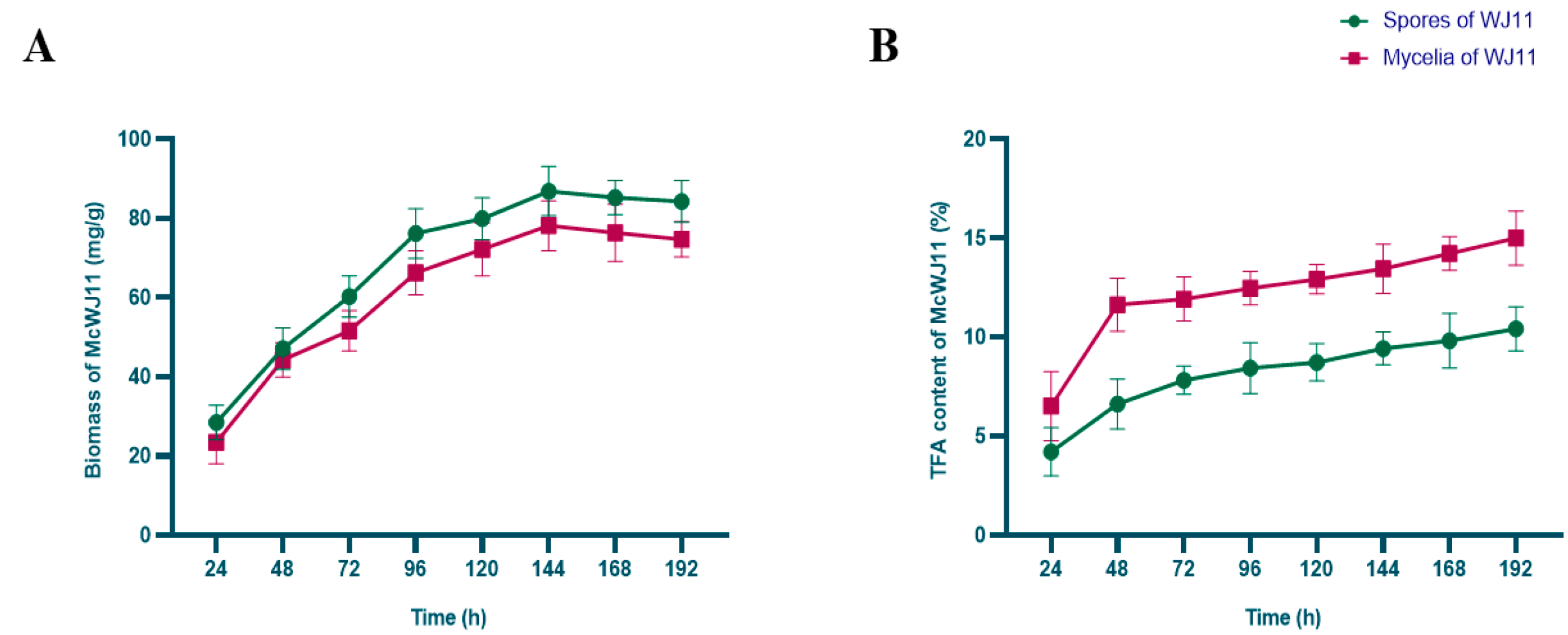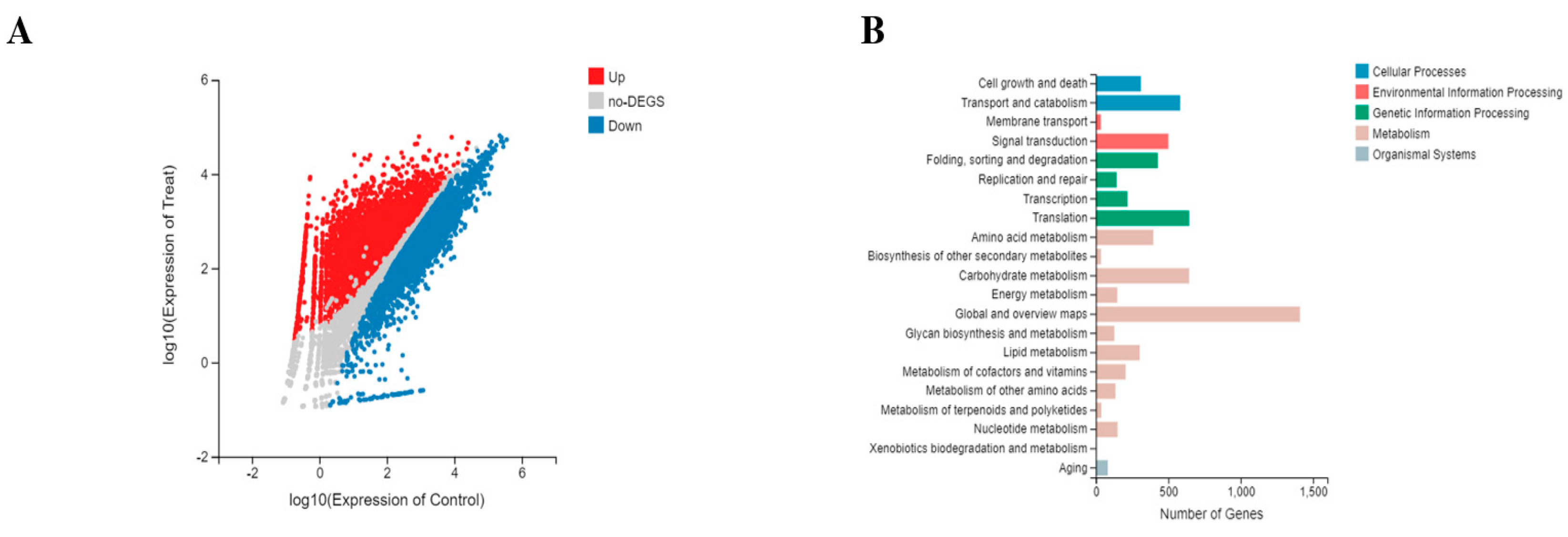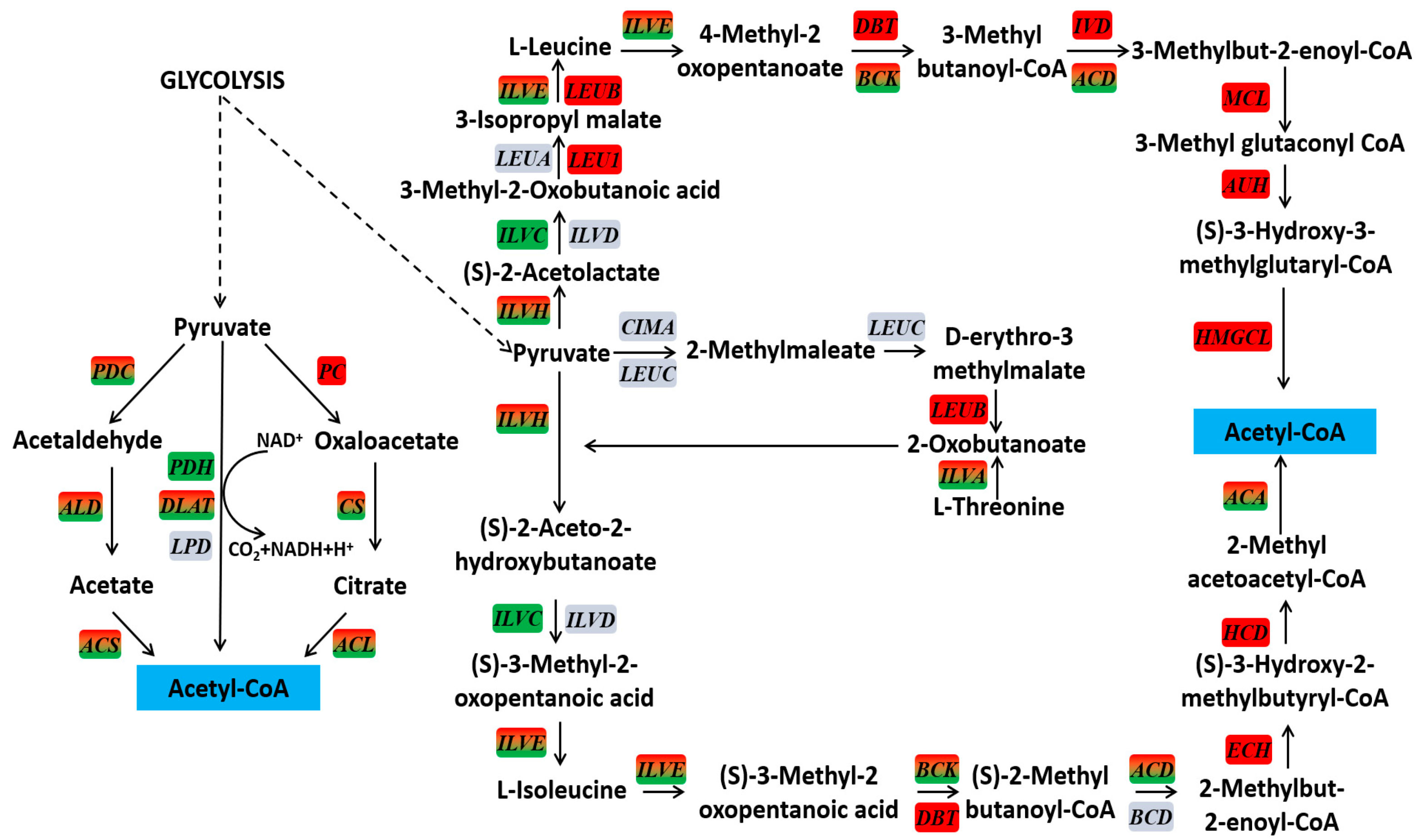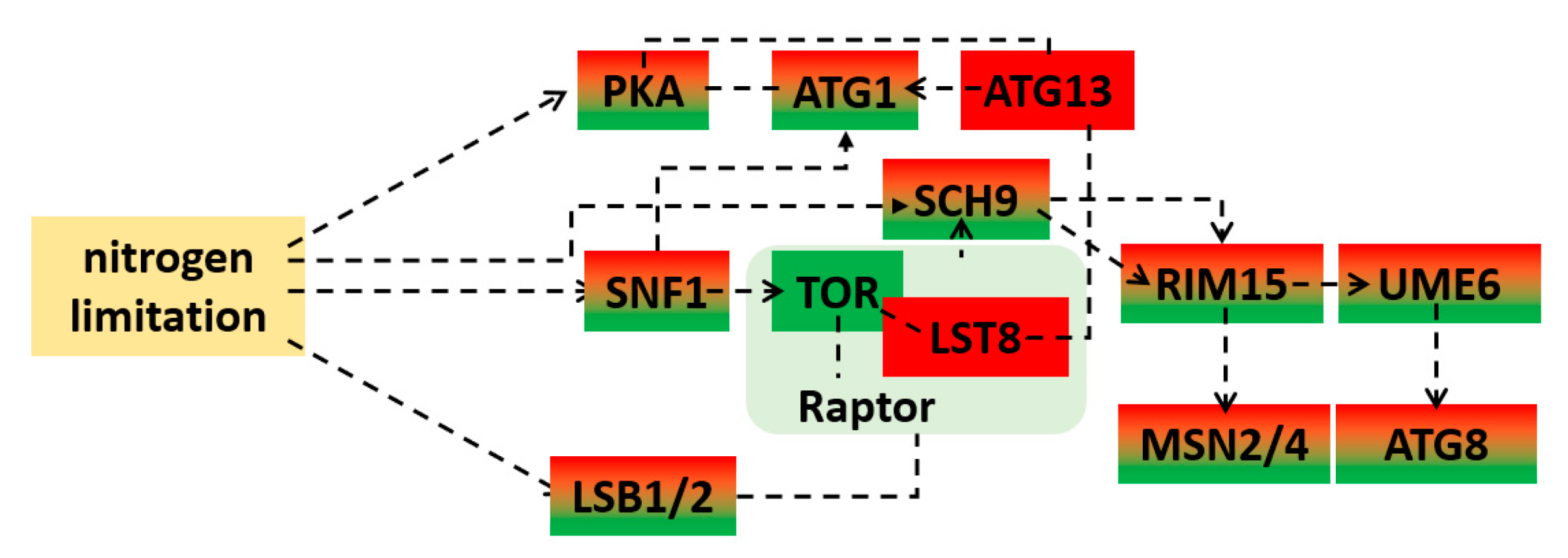Transcriptomic Analysis Revealed the Differences in Lipid Accumulation between Spores and Mycelia of Mucor circinelloides WJ11 under Solid–State Fermentation
Abstract
1. Introduction
2. Materials and Methods
2.1. Preparation of Fungal Spore Suspension and Solid–State Fermentation Medium
2.2. Separation of Spores and Mycelia under Solid–State Fermentation
2.3. Lipid Extraction and Fatty Acid Analysis
2.4. RNA Sequencing and Analyzes
2.5. Statistical Analysis
3. Results and Discussion
3.1. Cell Growth and Lipid Content of M. circinelloides under Solid–State Fermentation
3.2. RNA Sequencing and Analysis in Spores and Mycelia of M. circinelloides
3.3. The Expression Difference of Glycerolipid Biosynthesis between Spores and Mycelia of M. circinelloides
3.4. Multiple Acetyl-CoA Sources for Fatty Acid Synthesis in Spores and Mycelia of M. circinelloides
3.5. The Pentose Phosphate Pathway, Not Only a Malic Enzyme, Contributes the Main NADPH for Lipid Accumulation in M. circinelloides
3.6. Autophagy Was Associated with Lipid Accumulation in Spores and Mycelia of M. circinelloides
4. Conclusions
Supplementary Materials
Author Contributions
Funding
Institutional Review Board Statement
Informed Consent Statement
Data Availability Statement
Conflicts of Interest
References
- Yazawa, H.; Iwahashi, H.; Kamisaka, Y.; Kimura, K.; Aki, T.; Ono, K.; Uemura, H. Heterologous production of dihomo-gamma-linolenic acid in Saccharomyces cerevisiae. Appl. Environ. Microb. 2007, 73, 6965–6971. [Google Scholar] [CrossRef] [PubMed][Green Version]
- Ratledge, C. The role of malic enzyme as the provider of NADPH in oleaginous microorganisms: A reappraisal and unsolved problems. Biotechnol. Lett. 2014, 36, 1557–1568. [Google Scholar] [CrossRef] [PubMed]
- Tang, X.; Zan, X.; Zhao, L.; Chen, H.; Chen, Y.Q.; Chen, W.; Song, Y.; Ratledge, C. Proteomics analysis of high lipid-producing strain Mucor circinelloides WJ11: An explanation for the mechanism of lipid accumulation at the proteomic level. Microb. Cell Fact. 2016, 15, 35–51. [Google Scholar] [CrossRef] [PubMed]
- Wynn, J.P.; Hamid, A.A.; Li, Y.; Ratledge, C. Biochemical events leading to the diversion of carbon into storage lipids in the oleaginous fungi Mucor circinelloides and Mortierella alpina. Microbiology 2001, 147, 2857–2864. [Google Scholar] [CrossRef] [PubMed]
- Huang, Y.S.; Chaudhary, S.; Thurmond, J.M.; Bobik, E.G.; Yuan, L.; Chan, G.M.; Kirchner, S.J.; Mukerji, P.; Knutzon, D.S. Cloning of ∆12- and ∆6-Desaturases from Mortierella alpina and Recombinant Production of γ-Linolenic Acid in Saccharomyces cerevisiae. Lipids 1999, 34, 649–659. [Google Scholar] [CrossRef] [PubMed]
- Muniraj, I.K.; Uthandi, S.K.; Hu, Z.; Xiao, L.; Zhan, X. Microbial lipid production from renewable and waste materials for second-generation biodiesel feedstock. Environ. Technol. Rev. 2015, 4, 1–16. [Google Scholar] [CrossRef]
- Liu, L.; Song, J.; Li, Y.; Li, P.; Wang, H. Robust and cost-saving static solid cultivation method for lipid production using the chlamydospores of Phanerochaete chrysosporium. Biotechnol. Biofuels 2019, 12, 123–137. [Google Scholar] [CrossRef]
- Pandey, A.; Soccol, C.R.; Mitchell, D. New developments in solid state fermentation I-bioprocesses and products. Process Biochem. 2000, 35, 1153–1169. [Google Scholar] [CrossRef]
- Postigo, L.O.C.Y.; Jacobo-Velázquez, D.A.; Guajardo-Flores, D.; Amezquita, L.E.G.; García-Cayuela, T. solid–state fermentation for enhancing the nutraceutical content of agrifood by-products: Recent advances and its industrial feasibility. Food Biosci. 2021, 41, 100926–100936. [Google Scholar] [CrossRef]
- Slany, O.; Klempova, T.; Shapaval, V.; Zimmermann, B.; Kohler, A.; Certik, M. Biotransformation of Animal Fat-By Products into ARA-Enriched Fermented Bioproducts by solid–state Fermentation of Mortierella alpina. J. Fungi. 2020, 6, 236. [Google Scholar] [CrossRef]
- Yang, J.H.; Li, S.Q.; Khan, M.A.K.; Garre, V.; Vongsangnak, W.; Song, Y.D. Increased Lipid Accumulation in Mucor circinelloides by Overexpression of Mitochondrial Citrate Transporter Genes. Ind. Eng. Chem. Res. 2019, 58, 2125–2134. [Google Scholar] [CrossRef]
- Qiao, W.C.; Tao, J.Q.; Luo, Y.; Tang, T.H.; Miao, J.H.; Yang, Q.M. Microbial oil production from solid–state fermentation by a newly isolated oleaginous fungus, Mucor circinelloides Q531 from mulberry branches. R. Soc. Open Sci. 2018, 5, 180551–180562. [Google Scholar] [CrossRef] [PubMed]
- Xin, F.F.; Wang, R.X.; Chang, Y.F.; Gao, M.; Xie, Z.K.; Yang, W.; Chen, M.L.; Zhang, H.Y.; Song, Y.D. Homologous Overexpression of Diacylglycerol Acyltransferase in Oleaginous Fungus Mucor circinelloides WJ11 Enhances Lipid Accumulation under Static Solid Cultivation. J. Agric. Food Chem. 2022, 70, 9073–9083. [Google Scholar] [CrossRef]
- Mysyakina, I.S.; Funtikova, N.S. Lipid composition of the arthrospores, yeastlike cells, and mycelium of the fungus Mucor hiemalis. Microbiology 2001, 70, 403–407. [Google Scholar] [CrossRef]
- Tang, X.; Chen, H.; Chen, Y.Q.; Chen, W.; Garre, V.; Song, Y.; Ratledge, C. Comparison of Biochemical Activities between High and Low Lipid-Producing Strains of Mucor circinelloides: An Explanation for the High Oleaginicity of Strain WJ11. PLoS ONE 2015, 10, e0128396. [Google Scholar] [CrossRef] [PubMed]
- Folch, J.; Lees, M.; Sloane Stanley, G.H. A Simple Method for the Isolation and Purification of Total Lipides from Animal Tissues. J. Biol. Chem. 1957, 226, 497–509. [Google Scholar] [CrossRef]
- Zhang, Y.; Luan, X.; Zhang, H.; Garre, V.; Song, Y.; Ratledge, C. Improved gamma-linolenic acid production in Mucor circinelloides by homologous overexpressing of delta-12 and delta-6 desaturases. Microb. Cell Fact. 2017, 16, 113–122. [Google Scholar] [CrossRef]
- Love, M.I.; Huber, W.; Anders, S. Moderated estimation of fold change and dispersion for RNA-seq data with DESeq2. Genome Biol. 2014, 15, 550–571. [Google Scholar] [CrossRef]
- Couto, S.R.; Sanromán, M.A. Application of solid–state fermentation to ligninolytic enzyme production. Biochem. Eng. J. 2005, 22, 211–219. [Google Scholar] [CrossRef]
- Weiss, S.B.; Kennedy, E.P.; Kiyasu, J.Y. The Enzymatic Synthesis of Triglycerides. J. Biol. Chem. 1960, 235, 40–44. [Google Scholar] [CrossRef]
- Gao, Q.; Shang, Y.F.; Huang, W.; Wang, C.S. Glycerol-3-phosphate Acyltransferase contributes to triacylglycerol biosynthesis, lipid droplet formation, and host invasion in Metarhizium robertsii. Appl. Environ. Microb. 2013, 79, 7646–7653. [Google Scholar] [CrossRef] [PubMed]
- Misra, A.; Khan, K.; Niranjan, A.; Kumar, V.; Sane, V.A. Heterologous expression of two GPATs from Jatropha curcas alters seed oil levels in transgenic Arabidopsis thaliana. Plant Sci. 2017, 263, 79–88. [Google Scholar] [CrossRef] [PubMed]
- Zou, J.T.; Katavic, V.; Giblin, E.M.; Barton, D.L.; Mackenzie, S.L.; Keller, W.A.; Hu, X. Modification of Seed Oil Content and Acyl Composition in the Brassicaceae by Expression of a Yeast sn-2 Acyltransferase Gene. Plant Cell 1997, 9, 909–923. [Google Scholar] [CrossRef] [PubMed]
- Liu, X.Y.; Chi, Z.; Liu, G.L.; Madzak, C.; Chi, Z.M. Both decrease in ACL1 gene expression and increase in ICL1 gene expression in marine-derived yeast Yarrowia lipolytica expressing INU1 gene enhance citric acid production from inulin. Mar. Biotechnol. 2013, 15, 26–36. [Google Scholar] [CrossRef] [PubMed]
- Zhang, H.Y.; Zhang, L.N.; Chen, H.Q.; Chen, Y.Q.; Chen, W.; Song, Y.D.; Ratledge, C. Enhanced lipid accumulation in the yeast Yarrowia lipolytica by over-expression of ATP:citrate lyase from Mus musculus. J. Biotechnol. 2014, 192, 78–84. [Google Scholar] [CrossRef] [PubMed]
- Tamano, K.; Bruno, K.S.; Karagiosis, S.A.; Culley, D.E.; Deng, S.; Collett, J.R.; Umemura, M.; Koike, H.; Baker, S.E.; Machida, M. Increased production of fatty acids and triglycerides in Aspergillus oryzae by enhancing expressions of fatty acid synthesis-related genes. Appl. Microbiol. Biotechnol. 2013, 97, 269–281. [Google Scholar] [CrossRef]
- Wynn, J.; Ratledge, C. Malic Enzyme is a Major Source of NADPH for Lipid Accumulation by Aspergillus Nidulans. Microbiology 1997, 143, 253–257. [Google Scholar] [CrossRef]
- Hao, G.; Chen, H.; Wang, L.; Gu, Z.; Song, Y.; Zhang, H.; Chen, W.; Chen, Y.Q. Role of malic enzyme during fatty acid synthesis in the oleaginous fungus Mortierella alpina. Appl. Environ. Microb. 2014, 80, 2672–2678. [Google Scholar] [CrossRef]
- Zhang, Y.; Adams, I.P.; Ratledge, C. Malic enzyme: The controlling activity for lipid production? Overexpression of malic enzyme in Mucor circinelloides leads to a 2.5-fold increase in lipid accumulation. Microbiology 2007, 153, 2013–2025. [Google Scholar] [CrossRef]
- Zhang, H.; Zhang, L.; Chen, H.; Chen, Y.Q.; Ratledge, C.; Song, Y.; Chen, W. Regulatory properties of malic enzyme in the oleaginous yeast, Yarrowia lipolytica, and its non-involvement in lipid accumulation. Biotechnol. Lett. 2013, 35, 2091–2098. [Google Scholar] [CrossRef]
- Tang, X.; Chen, H.; Gu, Z.; Zhang, H.; Chen, Y.Q.; Song, Y.; Chen, W. Role of g6pdh and leuB on Lipid Accumulation in Mucor circinelloides. J. Agric. Food Chem. 2020, 68, 4245–4251. [Google Scholar] [CrossRef]
- Nosheen, S.; Naz, T.; Yang, J.; Hussain, S.A.; Fazili, A.B.A.; Nazir, Y.; Li, S.; Mohamed, H.; Yang, W.; Mustafa, K.; et al. Role of Snf-β in lipid accumulation in the high lipid-producing fungus Mucor circinelloides WJ11. Microb. Cell Fact. 2021, 20, 52–63. [Google Scholar] [CrossRef]
- Bakshi, A.; Moin, M.; Madhav, M.S.; Datla, R.; Kirti, P.B. Target of Rapamycin (TOR) negatively regulates chlorophyll degradation and lipid peroxidation and controls responses under abiotic stress in Arabidopsis thaliana. Plant Stress 2021, 2, 100020–100033. [Google Scholar] [CrossRef]
- Rajvanshi, P.K.; Arya, M.; Rajasekharan, R. The stress-regulatory transcription factors Msn2 and Msn4 regulate fatty acid oxidation in budding yeast. J. Biol. Chem. 2017, 292, 18628–18643. [Google Scholar] [CrossRef]
- Santos-Araujo, S.; Bomfim, L.; Araripe, L.O.; Bruno, R.; Ramos, I.; Gondim, K.C. Silencing of ATG6 and ATG8 promotes increased levels of triacylglycerol (TAG) in the fat body during prolonged starvation periods in the Chagas disease vector Rhodnius prolixus. Insect Biochem. Mol. Biol. 2020, 127, 103484–103498. [Google Scholar] [CrossRef]
- Lu, H.Q.; Chen, H.Q.; Tang, X.; Yang, Q.; Zhang, H.; Chen, Y.Q.; Chen, W. Autophagy Improves ARA-Rich TAG Accumulation in Mortierella alpina by Regulating Resource Allocation. Microbiol. Spectr. 2022, 10, e01300–e01321. [Google Scholar] [CrossRef]
- Rao, S.S.; Hildebrand, D. Changes in oil content of transgenic soybeans expressing the yeast SLC1 gene. Lipids 2009, 44, 945–951. [Google Scholar] [CrossRef]
- Ratledge, C.; Bowater, M.; Taylor, P.N. Correlation of ATP/Citrate Lyase Activity with Lipid Accumulation in Developing Seeds of Brassica napus L. Lipids 1997, 32, 7–12. [Google Scholar] [CrossRef]
- Boulton, C.A.; Ratledge, C. Correlation of Lipid Accumulation in Yeasts with Possession of ATP: Citrate Lyase. Microbiology 1981, 127, 169–176. [Google Scholar] [CrossRef]
- Krivoruchko, A.; Zhang, Y.; Siewers, V.; Chen, Y.; Nielsen, J. Microbial acetyl-CoA metabolism and metabolic engineering. Metab. Eng. 2015, 28, 28–42. [Google Scholar] [CrossRef]
- Tan, K.W.; Lin, H.; Shen, H.; Lee, Y.K. Nitrogen-induced metabolic changes and molecular determinants of carbon allocation in Dunaliella tertiolecta. Sci. Rep. 2016, 6, 37235. [Google Scholar] [CrossRef] [PubMed]
- Tang, X.; Chen, H.; Gu, Z.; Zhang, H.; Chen, Y.Q.; Song, Y.; Chen, W. Comparative Proteome Analysis between High Lipid-Producing Strain Mucor circinelloides WJ11 and Low Lipid-Producing Strain CBS 277.49. J. Agric. Food Chem. 2017, 65, 5074–5082. [Google Scholar] [CrossRef] [PubMed]
- Zhu, B.H.; Zhang, R.H.; Lv, N.N.; Yang, G.P.; Wang, Y.S.; Pan, K.H. The Role of Malic Enzyme on Promoting Total Lipid and Fatty Acid Production in Phaeodactylum tricornutum. Front. Plant Sci. 2018, 9, 826–834. [Google Scholar] [CrossRef] [PubMed]
- Rodriguez-Frometa, R.A.; Gutierrez, A.; Torres-Martinez, S.; Garre, V. Malic enzyme activity is not the only bottleneck for lipid accumulation in the oleaginous fungus Mucor circinelloides. Appl. Microbiol. Biot. 2013, 97, 3063–3072. [Google Scholar] [CrossRef]
- Lan, W.Z.; Qin, W.M.; Yu, L.J. Effect of glutamate on arachidonic acid production from Mortierella alpina. Lett. Appl. Microbiol. 2002, 35, 357–360. [Google Scholar] [CrossRef] [PubMed]
- Zhu, Z.; Zhang, S.; Liu, H.; Shen, H.; Lin, X.; Yang, F.; Zhou, Y.J.; Jin, G.; Ye, M.; Zou, H. Corrigendum: A multi-omic map of the lipid-producing yeast Rhodosporidium toruloides. Nat. Commun. 2013, 3, 1112–1123. [Google Scholar] [CrossRef]
- Liu, H.W.; Zhao, X.; Wang, F.J.; Li, Y.H.; Jiang, X.N.; Ye, M.L.; Zhao, Z.K.; Zou, H.F. Comparative proteomic analysis of Rhodosporidium toruloides during lipid accumulation. Yeast 2010, 26, 553–566. [Google Scholar] [CrossRef]
- Morin, N.; Cescut, J.; Beopoulos, A.; Lelandais, G.; Le Berre, V.; Uribelarrea, J.L.; Molina-Jouve, C.; Nicaud, J.M. Transcriptomic analyses during the transition from biomass production to lipid accumulation in the oleaginous yeast Yarrowia lipolytica. PLoS ONE 2011, 6, e27966. [Google Scholar] [CrossRef]
- Liu, Y.; Bassham, D.C. Autophagy: Pathways for self-eating in plant cells. Annu. Rev. Plant Biol. 2012, 63, 215–237. [Google Scholar] [CrossRef]
- Singh, R.; Kaushik, S.; Wang, Y.; Xiang, Y.; Novak, I.; Komatsu, M.; Tanaka, K.; Cuervo, A.M.; Czaja, M.J. Autophagy regulates lipid metabolism. Nature 2009, 458, 1131–1135. [Google Scholar] [CrossRef]
- Fan, J.L.; Yu, L.H.; Xu, C.C. Dual Role for Autophagy in Lipid Metabolism in Arabidopsis. Plant Cell 2019, 31, 1598–1613. [Google Scholar] [CrossRef]
- Couso, I.; Perez-Perez, M.E.; Martinez-Force, E.; Kim, H.S.; He, Y.; Umen, J.G.; Crespo, J.L. Autophagic flux is required for the synthesis of triacylglycerols and ribosomal protein turnover in Chlamydomonas. J. Exp. Bot. 2018, 69, 1355–1367. [Google Scholar] [CrossRef]
- Zhao, R.Q. Expression, purification and characterization of the plant Snf1-related protein kinase 1 from Escherichia coli. Protein. Expres. Purif. 2019, 162, 24–31. [Google Scholar] [CrossRef]
- Wei, H.; Wang, W.; Knoshaug, E.P.; Chen, X.; Van Wychen, S.; Bomble, Y.J.; Himmel, M.E.; Zhang, M. Disruption of the Snf1 Gene Enhances Cell Growth and Reduces the Metabolic Burden in Cellulase-Expressing and Lipid-Accumulating Yarrowia lipolytica. Front. Microbiol. 2021, 12, 757741–757754. [Google Scholar] [CrossRef]
- Wang, Q.; Hou, S. The emerging roles of ATG1/ATG13 kinase complex in plants. J. Plant Physiol. 2022, 271, 153653–156664. [Google Scholar] [CrossRef]
- Seo, M.J.; Choi, H.S.; Jeon, H.J.; Woo, M.S.; Lee, B.Y. Baicalein inhibits lipid accumulation by regulating early adipogenesis and m-TOR signaling. Food Chem. Toxicol. 2014, 67, 57–64. [Google Scholar] [CrossRef]
- Novarina, D.; Guerra, P.; Milias-Argeitis, A. Vacuolar Localization via the N-terminal Domain of Sch9 is Required for TORC1-dependent Phosphorylation and Downstream Signal Transduction. J. Mol. Biol. 2021, 433, 167326–167338. [Google Scholar] [CrossRef]
- Wood, N.E.; Kositangool, P.; Hariri, H.; Marchand, A.J.; Henne, W.M. Nutrient Signaling, Stress Response, and Inter-organelle Communication Are Non-canonical Determinants of Cell Fate. Cell Rep. 2020, 33, 108446–108461. [Google Scholar] [CrossRef]
- Varshavsky, A. The Ubiquitin System, Autophagy, and Regulated Protein Degradation. Annu. Rev. Biochem. 2017, 86, 123–128. [Google Scholar] [CrossRef] [PubMed]
- Shibata, M.; Yoshimura, K.; Furuya, N.; Koike, M.; Ueno, T.; Komatsu, M.; Arai, H.; Tanaka, K.; Kominami, E.; Uchiyama, Y. The MAP1-LC3 conjugation system is involved in lipid droplet formation. Biochem. Biophys. Res. Commun. 2009, 382, 419–423. [Google Scholar] [CrossRef]





| Component | Time (h) | Fatty Acid Composition (%) | ||||||
|---|---|---|---|---|---|---|---|---|
| C14:0 | C16:0 | C16:1 | C18:0 | C18:1 | C18:2 | C18:3 | ||
| Spores | 24 | 1.5 ± 0.3 | 17.1 ± 0.4 | 2.1 ± 0.3 | 5.0 ± 0.4 | 33.5 ± 0.5 | 17.8 ± 0.1 | 22.9 ± 0.3 |
| 48 | 1.9 ± 0.3 | 17.9 ± 0.2 | 3.1 ± 0.5 | 2.4 ± 0.2 | 42.5 ± 0.4 | 13.5 ± 0.2 | 18.7 ± 0.4 | |
| 96 | 1.9 ± 0.4 | 19.4 ± 0.5 | 2.8 ± 0.3 | 2.4 ± 0.3 | 39.8 ± 0.1 | 13.5 ± 0.2 | 20.5 ± 0.1 | |
| 144 | 1.9 ± 0.1 | 18.0 ± 0.4 | 3.0 ± 0.2 | 2.4 ± 0.1 | 42.5 ± 0.5 | 13.5 ± 0.3 | 18.5 ± 0.1 | |
| 192 | 1.8 ± 0.2 | 17.7 ± 0.3 | 3.0 ± 0.3 | 2.3 ± 0.3 | 43.9 ± 0.4 | 13.0 ± 0.5 | 18.1 ± 0.4 | |
| Mycelia | 24 | 1.8 ± 0.3 | 12.5 ± 0.1 | 3.6 ± 0.1 | 5.6 ± 0.2 | 41.9 ± 0.6 | 17.4 ± 0.3 | 17.1 ± 0.4 |
| 48 | 1.4 ± 0.2 | 19.6 ± 0.5 | 2.8 ± 0.3 | 4.8 ± 0.2 | 41.9 ± 0.3 | 12.4 ± 0.4 | 17.1 ± 0.2 | |
| 96 | 1.3 ± 0.1 | 20.0 ± 0.3 | 2.4 ± 0.3 | 4.8 ± 0.2 | 41.1 ± 0.2 | 12.6 ± 0.2 | 17.6 ± 0.5 | |
| 144 | 1.4 ± 0.1 | 19.6 ± 0.5 | 2.8 ± 0.1 | 4.6 ± 0.5 | 42.0 ± 0.3 | 12.4 ± 0.5 | 17.2 ± 0.2 | |
| 192 | 1.4 ± 0.3 | 19.6 ± 0.2 | 2.7 ± 0.2 | 4.3 ± 0.3 | 42.7 ± 0.6 | 11.8 ± 0.2 | 17.6 ± 0.5 | |
| Sample | Total Raw Reads (M) | Total Clean Reads (M) | Total Clean Bases (Gb) | Clean Reads Q20 (%) | Clean Reads Q30 (%) | Clean Reads Ratio (%) |
|---|---|---|---|---|---|---|
| MWJ11_1 | 45.57 | 43.57 | 6.54 | 96.93 | 92.23 | 95.6 |
| MWJ11_2 | 43.82 | 42.01 | 6.3 | 96.87 | 92.08 | 95.86 |
| MWJ11_3 | 43.82 | 42.04 | 6.31 | 96.9 | 92.13 | 95.93 |
| SWJ11_1 | 45.57 | 42.97 | 6.45 | 96.78 | 91.88 | 94.28 |
| SWJ11_2 | 45.57 | 42.87 | 6.43 | 96.89 | 92.19 | 94.07 |
| SWJ11_3 | 45.57 | 43.17 | 6.48 | 96.91 | 92.19 | 94.73 |
| Strain | Gene Name and Modification Method | Lipid Content Changes | Reference |
|---|---|---|---|
| Mucor circinelloides | homologously overexpressed DGAT2B | the TFA content in mycelia increased by 68.0% (from 13.6 to 22.8%) | [13] |
| Arabidopsis thaliana | overexpressed GPAT2 from Jatropha curcas (Acc. No. NBRI-UA-Alm-0406) | the oil content was enhanced by 60% (from 33.3 to 53.5 mg/100 mg) | [22] |
| Brassica napus cv Hero | overexpressed LPAT from yeast Saccharomyces cerevisiae | the seed oil content increased from 6.1 to 8.2% | [23] |
| Yarrowia lipolytica | ACL mutant | decreased by 36% | [24] |
| Yarrowia lipolytica | overexpressed ACL from Mus musculus | the lipid content increased from 7% to 23% | [25] |
| Aspergillus oryzae | modified the ACL promoter | the fatty acid content increased by 1.7-fold | [26] |
| Aspergillus nidulans | lacked ME activity mutant | the lipid content was reduced to half of the original | [27] |
| Mortierella alpina | homologously expressed the gene encoding ME isoform E | the fatty acid content increased by 30% compared to that of the control | [28] |
| Mucor circinelloides | homologously expressed the ME | the lipid content of cells increased from 12% to 30% of the biomass | [29] |
| Yarrowia lipolytica | overexpressed the ME gene (mce2) from Mortierella alpina | the lipid content was no significant changes | [30] |
| Mucor circinelloides | homologously overexpressed g6pdh1 and g6pdh2 genes encoding G6PDH | the fatty acid content of CDW increased by 23–38% and 41–47%, respectively | [31] |
| Mucor circinelloides | knockout SNF-β | the lipid content increased by 32% (from 19.0% to 25.0%) | [32] |
| Arabidopsis thaliana | homologously overexpressed TOR | negatively regulated lipid peroxidation | [33] |
| Yarrowia lipolytica | MSN2/4 double mutant | triacylglycerol and steroidal esters were increased | [34] |
| Rhodnius prolixus | Silenced Atg6/Beclin1 and Atg8/LC3 | accumulated higher levels of triglycerides | [35] |
| Mortierella alpina | homologously overexpressed ATG8 | the fatty acid content increased by approximately 110% compared with the wildtype strain | [36] |
Publisher’s Note: MDPI stays neutral with regard to jurisdictional claims in published maps and institutional affiliations. |
© 2022 by the authors. Licensee MDPI, Basel, Switzerland. This article is an open access article distributed under the terms and conditions of the Creative Commons Attribution (CC BY) license (https://creativecommons.org/licenses/by/4.0/).
Share and Cite
Xin, F.; Dang, W.; Chang, Y.; Wang, R.; Yuan, H.; Xie, Z.; Zhang, C.; Li, S.; Mohamed, H.; Zhang, H.; et al. Transcriptomic Analysis Revealed the Differences in Lipid Accumulation between Spores and Mycelia of Mucor circinelloides WJ11 under Solid–State Fermentation. Fermentation 2022, 8, 667. https://doi.org/10.3390/fermentation8120667
Xin F, Dang W, Chang Y, Wang R, Yuan H, Xie Z, Zhang C, Li S, Mohamed H, Zhang H, et al. Transcriptomic Analysis Revealed the Differences in Lipid Accumulation between Spores and Mycelia of Mucor circinelloides WJ11 under Solid–State Fermentation. Fermentation. 2022; 8(12):667. https://doi.org/10.3390/fermentation8120667
Chicago/Turabian StyleXin, Feifei, Wenrui Dang, Yufei Chang, Ruixue Wang, Hongjuan Yuan, Zhike Xie, Chuanchuan Zhang, Sha Li, Hassan Mohamed, Huaiyuan Zhang, and et al. 2022. "Transcriptomic Analysis Revealed the Differences in Lipid Accumulation between Spores and Mycelia of Mucor circinelloides WJ11 under Solid–State Fermentation" Fermentation 8, no. 12: 667. https://doi.org/10.3390/fermentation8120667
APA StyleXin, F., Dang, W., Chang, Y., Wang, R., Yuan, H., Xie, Z., Zhang, C., Li, S., Mohamed, H., Zhang, H., & Song, Y. (2022). Transcriptomic Analysis Revealed the Differences in Lipid Accumulation between Spores and Mycelia of Mucor circinelloides WJ11 under Solid–State Fermentation. Fermentation, 8(12), 667. https://doi.org/10.3390/fermentation8120667







